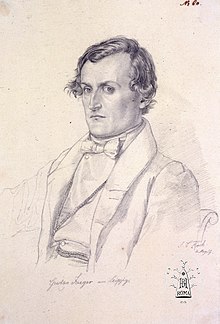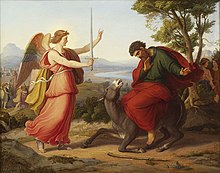Gustav Jäger (painter)

Gustav Jäger (born July 12, 1808 in Leipzig ; † April 19, 1871 there ) was a German painter.
Life
Gustav Jäger was first trained at the academy in Leipzig (with Veit Hanns Schnorr von Carolsfeld ), then briefly in Dresden at the academy and in 1830 went to Munich, where he joined Julius Schnorr von Carolsfeld . He painted biblical paintings in the view of the Nazarenes .
In Rome, where he went in 1836, he painted the picture of Balaam with the angel. In 1836/37 he was in Rome and in 1837 in Naples. Several of his paintings were acquired by the Duke of Weimar and King of Saxony. In 1837 he was called to Munich and took part under Schnorr von Carolsfeld in the frescoes in the Königsbau, namely in the painting of the Habsburg and Barbarossa rooms as well as in the smaller depictions in the hall of Karl the Elder. Size
Turning back to oil painting, he created a burial of Christ on it (exhibited in Munich in 1845 and then in the Leipzig Museum). In 1847 he became director of the Academy in Leipzig , but in 1850 he took over the execution of one of the large frescoes in the fourth Nibelungen Hall in Munich in place of Schnorr. In the late 1830s he was commissioned by Cotta to illustrate a splendid edition of the Bible, which appeared in 1850.
He painted the Herder room in the Weimar City Palace (completed in 1848) with themes from Herder's poetry. Other wall paintings by Jäger can be found in the churches at Schönefeld and Klein-Pötzschau near Leipzig and in the auditorium of the Teichmann school there.
In addition, he painted easel paintings, such as: Magdalena at Christ's feet, etc. His works encompass a small circle, but the more intimate is the feeling with which they were created. He was more skilled in fresco painting than in oil painting. The altarpiece "Christ as Prince of Peace" in the Christ Church in Rüdigsdorf was executed by Jäger as a reverse glass painting. Jäger died in Leipzig on April 19, 1871.
He was a gifted portrait draftsman, but practiced this subject little. In 1837 his portrait was made as a drawing by Johann Carl Koch .
His son was the pastor Hans Jäger in Kiebitz near Oschatz.
literature
- Hyacinth Holland : Jaeger, Gustav . In: Allgemeine Deutsche Biographie (ADB). Volume 13, Duncker & Humblot, Leipzig 1881, p. 649 f.
- Hans Vollmer: Hunter, Gustav . In: Hans Vollmer (Hrsg.): General lexicon of fine artists from antiquity to the present . Founded by Ulrich Thieme and Felix Becker . tape 19 : Ingouville – Kauffungen . EA Seemann, Leipzig 1926, p. 331-332 .
Individual evidence
- ↑ Thieme-Becker
- ^ Bibliotheca Hertziana , accessed on January 3, 2014.
| personal data | |
|---|---|
| SURNAME | Hunter, Gustav |
| ALTERNATIVE NAMES | Jaeger, Gustav |
| BRIEF DESCRIPTION | German painter |
| DATE OF BIRTH | July 12, 1808 |
| PLACE OF BIRTH | Leipzig |
| DATE OF DEATH | April 19, 1871 |
| Place of death | Leipzig |
